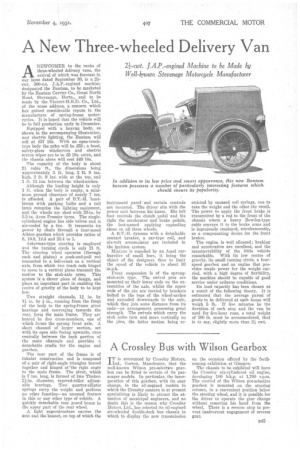A New Three-wheeled Delivery Van
Page 63

If you've noticed an error in this article please click here to report it so we can fix it.
ANEWCOMER to the ranks of three-wheeled delivery vans, the arrival of which was forecast in our issue dated September 30, is a 2icwt. 300-c.e. J.A.P.-eng,ined machine designated the Bantam, to be marketed by the Bantam Carrier Co., Great North Road, Stevenage, Herts., and to be made by the Vincent-H.R.D. Co., Ltd., of the same address, a concern which has gained considerable repute in the manufacture of spring-frame motorcycles. It is hoped that the vehicle will be in full production early in December.
Equipped with a box-van body, as shown in the accompanying illustration, and electric lighting, the Bantam will sell at £57 10s. With an open-trucktype body the price will be £53; a hood, safety-glass windscreen and electric screen wiper are to be £5 10s. extra, and the chassis alone will cost 149 10s.
The capacity of the body is about 21 cubic ft., the dimensions being approximately 3 ft. long, 2 ft. 9 ins. high, 2 ft. 9 ins, wide at the top, and 1 ft. 11 ins, between the wheel-arches.
Although the loading height is only 1 ft. when the body is empty, a minimum ground clearance of nearly 7 ins. is afforded. A pair of B.T.-11 'headlamps with parking bulbs and a tail lamp comprise the lighting equipment, and the wheels are shod with 26-in. by 3.5-in. Avon Premier tyres. The singlecylindered engine has side valves and is air-cooled by a fan. It transmits its power by chain through a four-speed Albion gearbox which provides ratios of S, 10.8, 14.4 and 23.4 to 1.
Ackerman-type steering is employed and the turning circle is only 21 ft. The steering wheel operates (through rack and pinion) a push-and-pull rod connected to a bell-crank on a vertical axis, from which two track rods hinged to move in a vertical plane transmit the motion to the stub-axle arms. This system is a clever piece of design, and plays an important part in enabling the centre of gravity of the body to be kept low.
Two straight channels, 11 in. by 1a in, by i in., running from the front of the body to the spring-frame pivot bearings and converging towards the rear, form the main frame. They are braced by five cross-members, one of which forms the sprung front axle. A short channel of larger section, set with its open side facing upwards, runs centrally between the back portion of the main channels and provides a detachable cradle for the engine and
gearbox. '
The rear part of the frame is of tubular construction and is composed of a pair of right-angle triangles braced together and hinged at the right angle to the main frame. The pivot, which is 7 ins, long, is formed of two Timken 2i-in. diameter, tapered-roller adjustable bearings. Two quarter-elliptic springs carry the weight and perform no other function—an unusual feature in this or any other type of vehicle. A quickly detachable rear guard boxes in the upper part of the rear wheel.
A light superstructure carries the seat and the bonnet, on top of which the
instrument panel and certain controls are mounted. The driver sits with the power unit between his knees. His left foot controls the clutch pedal and his right the accelerator and brake pedals, the last-named applying expanding shoes on all three wheels.
A B.T.-H. dynamo with a detachable contact breaker, a car-type con, and six-volt accumulator are included in the ignition system.
Mixture is supplied by an Amal carburetter of small bore, it being the object of the designers thus to limit the speed of the vehicle to about 30 Front suspension is of the sprungstub-axle type. The swivel pins are mounted at their lower ends on the extremities of the axle, whilst the upper ends of the pin are carried by brackets bolted to the tops of the wheel-arches and extended downwards to the axle, which they join some distance from its ends—an arrangement possessing great strength. The swivels which carry the stub axles turn and move vertically on the pins, the latter motion being re
stricted by encased coil springs, one to take the weight and the other the recoil. The power to apply the front brake is transmitted by a rod to the front of the chassis where a heavy Bowden-type cable conveys it to the brake arms and is ingeniously employed, simultaneously, as a compensating device for the front brakes.
The engine is well silenced; braking and acceleration are excellent, and the manmuvrability of the little vehicle remarkable. With its low centre of gravity, its small turning circle, a fourspeed gearbox and an engine that provides ample power for the weight carried, with a high degree of flexibility, the machine should be capable of good service under arduous conditions.
Its load capacity has been chosen as a result of the following theory. It is estimated that the average parcel of goods to be delivered at each house will weigh 5 lb. If five minutes be the duration of each stop and the van be used for five-hour runs, a total weight of 300 lb. must be accommodated, that is to say, slightly more than 2i cwt.




































































































